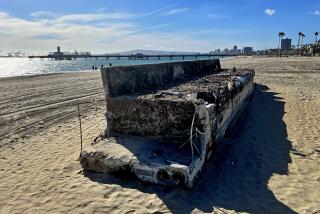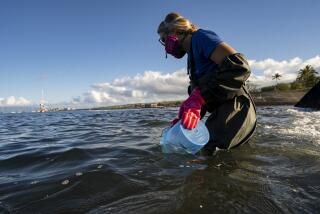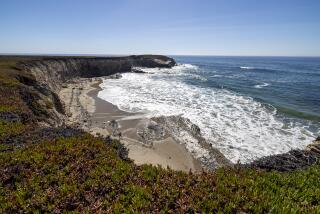Canoe voyage from Hawaii to California aims to raise environmental awareness, connect with island culture
A double-hulled voyaging canoe crafted using an ancient design set sail from Hawaii on Saturday to raise awareness about an all-too-modern problem.
As it travels from Honolulu to San Francisco, the Hikianalia, a contemporary take on a traditional Polynesian voyaging canoe, will traverse the vast mass of floating debris and trash known as the Great Pacific Garbage Patch.
Nainoa Thompson, president of the Polynesian Voyaging Society, which is sponsoring the trip, said the vessel’s crew is excited about what they may learn from navigating through the debris field the size of Alaska.
“We feel that this is part of our responsibility,” he said. “You can’t protect what you don’t understand. We want to be involved and try to do something about the garbage patch.”
The deep-sea voyaging canoe was originally scheduled to depart July 30, but was delayed due to unfavorable weather conditions caused first by Hurricane Hector and then by Hurricane Lane. The canoe set off at 7 a.m. and voyage organizers hope it will complete the 2,800-mile voyage in time for the Global Climate Action Summit being held in San Francisco Sept. 12-14. Gov. Jerry Brown has invited Thompson to speak at the summit’s session on “Healthy Oceans.”
In Hawaiian, the expedition is called the “Alahula Kai o Maleka,” a reference to the pathway across the “Sea of America” that connects Hawaii and California.
In the 1980s, scientists made an alarming discovery — that a huge collection of plastic and floating trash had accumulated halfway along the route.
The 13-member crew of the Hikianalia will be attaching tracking devices to the debris they find in the Great Pacific Garbage Patch, checking on the stomach content in fish, and conducting research and collaborating with scientists from Hawaii and California. The voyage is viewed as a chance to educate the public about the ocean, and the crew will post regular science updates at hokulea.com and on Facebook and Instagram.
Along with raising public awareness about environmental problems, the voyage has a cultural mission as well.
Founded in 1973, the Polynesian Voyaging Society initially wanted to revive the art of wayfinding, navigating without instruments, guided only by the signs of nature — the sun, moon, stars, birds, waves and ocean swells. The group also wanted to demonstrate that it was possible for Polynesians to have explored and settled the Pacific Ocean.
The wayfinding tradition had nearly been lost in Polynesia, until the society in 1975 built the famed Hokulea, a replica of a traditional Polynesian double-hulled canoe. Then the society found an expert navigator in Micronesia. Under his guidance, Thompson became the first Hawaiian in 600 years skilled in wayfinding. And it changed his life.
“I was born and raised in a school system that didn’t value things Hawaiian. I graduated from high school having no idea who my ancestors are, where they come from, and the fact that they were the greatest navigators on the face of the Earth. And why is it important? Because self-esteem, identity, self-worth matters. When those values are negative, you have very devastating consequences to a native people,” Thompson said.
Ever since Hokulea, which means Star of Gladness, first sailed from Hawaii to Tahiti in 1976, it sparked a revival of Polynesian voyaging throughout the Pacific. In 1995, Hokulea was shipped to Seattle and it sailed down the West Coast, to San Francisco, Los Angeles and San Diego. Then it was shipped back to Hawaii.
In 2012 the society launched the Hikianalia, which initially served as an escort vessel for the Hokulea. At 72 feet, it’s 10 feet longer than the Hokulea and serves as a floating classroom. Both canoes are propelled by twin sails, but the Hikianalia also has a motor that can be used in emergencies. That motor, however, is solar-powered, so the vessel leaves no carbon footprint.
One of the missions of the society is to train and inspire a new generation of voyagers, and this journey’s crew is a diverse group, ranging in age from 19 to the late 60s and made up of people from Hawaii, Tahiti, South Korea and Japan.
The captain on this trip is Lehua Kamalu, who is 32, fluent in Hawaiian and mindful of how sea travel links people to the natural world.
“I think wayfinding is an important thing to pass on in this day and age because it’s not just locating islands and navigating across the ocean to places,” she said. “It’s trying to create an atmosphere and environment where people develop themselves. A traditional wayfinder is someone who is deeply connected to the world around them.… You not only pay attention to the natural world, you pay attention to the people around you.”

This is the first time the Hikianalia will sail from from Hawaii to California. After San Francisco, stops are scheduled down the California coast in Monterey, Los Angeles and San Diego. The crew plans to connect with schools and communities along the way, including the state’s Hawaiian, Pacific Islander and indigenous communities.
“My great hope there is that there’s going to be this exchange, based on common values and a shared vision,” Thompson said. “We’re going to need these relationships to move forward to create the kind of change that we need — to protect this world for the benefit of our children.”
The canoe is scheduled to return to Hawaii in December.
More to Read
Start your day right
Sign up for Essential California for news, features and recommendations from the L.A. Times and beyond in your inbox six days a week.
You may occasionally receive promotional content from the Los Angeles Times.






